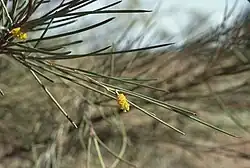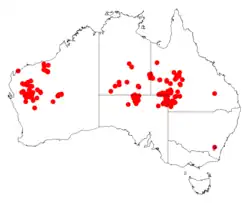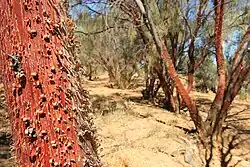Acacia cyperophylla
| Creekline miniritchie | |
|---|---|

| |
| Scientific classification | |
| Kingdom: | Plantae |
| Clade: | Tracheophytes |
| Clade: | Angiosperms |
| Clade: | Eudicots |
| Clade: | Rosids |
| Order: | Fabales |
| Family: | Fabaceae |
| Subfamily: | Caesalpinioideae |
| Clade: | Mimosoid clade |
| Genus: | Acacia |
| Species: | A. cyperophylla
|
| Binomial name | |
| Acacia cyperophylla | |

| |
| Occurrence data from AVH | |


Acacia cyperophylla, commonly known as creekline miniritchie, red mulga,[2] or mineritchie[3] is a species of flowering plant in the family Fabaceae and is endemic to northern Australia. It is a shrub or usually a tree with minni ritchi bark, straight or slightly curved phyllodes with a sharp point on the end, spikes of pale yellow flowers and narrowly oblong to linear, more or less woody pods.
Description
Acacia cyperophylla is a multi-stemmed shrub, or usually a tree that typically grows to a height of up to 12 m (39 ft) and has minni ritchi bark. Its phyllodes are more or less erect or pendulous, straight or slightly curved, more or less terete, 70–280 mm (2.8–11.0 in) long and usually 0.8–2 mm (0.031–0.079 in) wide with a sharp point on the end. The flowers are pale yellow and borne in spikes 10–30 mm (0.39–1.18 in) long. Flowering time depends on the variety, and the pods are narrowly oblong to linear, more or less flat, straight-sided or slightly constricted between the seeds, 40–160 mm (1.6–6.3 in) long and more or less woody.[3][2]
Taxonomy
Acacia cyperophylla was first formally described in 1864 by George Bentham in his Flora Australiensis from an unpublished description by Ferdinand von Mueller.[4][5] The specific epithet (cyperophylla) means 'sedge-leaved'.[3]
In 1991, Bruce Maslin described Acacia cyperophylla var. omearana in the The Western Australian Naturalist,[6] and the name and that of the autonym are accepted by the Australian Plant Census:
- Acacia cyperophylla F.Muell. ex Benth. var. cyperophylla (the autonym)[7] has end branchlets that are not pendulous, more or less erect phyllodes, flowers from May to December, probably sporadic after good rains, and pods commonly 4–5 mm (0.16–0.20 in) wide in Western Australia and 6–11 mm (0.24–0.43 in) wide in eastern Australia.[2][6][8][9]
- Acacia cyperophylla var. omearana Maslin[10] has pendulous end branchlets and phyllodes, flowers recorded in March and October, the pods 7–9 mm (0.28–0.35 in) wide.[2][6][11][12]
The varietal name (omeara) honours Denis O'Meara, who discrovered the variety around 1980.[11][6]
Distribution and habitat
The species' range extends across arid and semi-arid regions of from Carnarvon in Western Australia through the Northern Territory and northern South Australia to western Queensland. It is commonly found growing in drainage lines and on the banks of rivers and creeks.[13]
Variety omeara is only known from the Pilbara bioregion.[11]
Conservation status
The variety cyperophylla is listed as "not threatened",[14] but var. omeara is listed as "Priority One" by the Government of Western Australia Department of Biodiversity, Conservation and Attractions,[15] meaning that it is known from only one or a few locations where it is potentially at risk.[16]
See also
References
- ^ "Acacia cyperophylla". Australian Plant Census. Retrieved 19 August 2025.
- ^ a b c d "Acacia cyperophylla". World Wide Wattle. Retrieved 19 August 2025.
- ^ a b c Tindale, Mary D.; Kodela, Phillip G. Kodela, Phillip G. (ed.). "Acacia cyperophylla". Flora of Australia. Australian Biological Resources Study, Department of Climate Change, Energy, the Environment and Water: Canberra. Retrieved 19 August 2025.
- ^ "Acacia cyperophylla". APNI. Retrieved 19 August 2025.
- ^ Bentham, George (1864). Flora Australiensis. Vol. 2. London: Lovell Reeve & Co. p. 400. Retrieved 19 August 2025.
- ^ a b c d Maslin, Bruce R. (1991). "Acacia cyperophylla var. omearana, a new variety of 'Minni Ritchi' Acacia from the Pilbara Region of Western Australia". Western Australian Naturalist. 18 (7): 184–188. Retrieved 20 August 2025.
- ^ "Acacia cyperophylla var. cyperophylla". Australian Plant Census. Retrieved 19 August 2025.
- ^ Tindale, Mary D.; Kodela, Phillip G. Maslin, Bruce R.; Kodela, Phillip G.; Orchard, Anthony E. (eds.). "Acacia cyperophylla var. cyperophylla". Flora of Australia. Australian Biological Resources Study, Department of Climate Change, Energy, the Environment and Water: Canberra. Retrieved 19 August 2025.
- ^ "Acacia cyperophylla var. cyperophylla". Australian Biological Resources Study. Retrieved 20 August 2025.
- ^ "Acacia cyperophylla var. omearana". Australian Plant Census. Retrieved 19 August 2025.
- ^ a b c Tindale, Mary D.; Kodela, Phillip G. Maslin, Bruce R.; Kodela, Phillip G.; Orchard, Anthony E. (eds.). "Acacia cyperophylla var. omearana". Flora of Australia. Australian Biological Resources Study, Department of Climate Change, Energy, the Environment and Water: Canberra. Retrieved 19 August 2025.
- ^ "Acacia cyperophylla var. omearana". Australian Biological Resources Study. Retrieved 20 August 2025.
- ^ "Acacia cyperophylla". FloraBase. Western Australian Government Department of Biodiversity, Conservation and Attractions.
- ^ "Acacia cyperophylla var. cyperophylla". FloraBase. Western Australian Government Department of Biodiversity, Conservation and Attractions.
- ^ "Acacia cyperophylla var. omeara". FloraBase. Western Australian Government Department of Biodiversity, Conservation and Attractions.
- ^ "Conservation codes for Western Australian Flora and Fauna" (PDF). Government of Western Australia Biodiversity, Conservation and Attractions. Retrieved 20 August 2025.